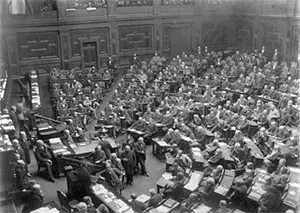Political Parties of the German Imperial Government
The members of the Reichstag, the German Imperial Parliament, were of various political parties. The most powerful party in 1871, the year of the first federal elections, was the National Liberal Party, which won 117 of the 382 seats in the Reichstag. Other political parties with more than two dozen members that year were the Centre Party (58), the Conservative Party (56), the German Progress Party (45), the German Reich Party (37), and the Imperial Liberty Party (33). The only other political party with members in double digits was the Polish Party, which had 13. The political parties had varying ideologies:

The National Liberty Party had the most seats until 1881, when the Centre Party scored a dominant victory, winning 100 of the 397 available seats (membership having increased by special proviso). Also making gains were the German Progress Party (58), the German Conservative Party (50), and the new Liberal Union Party (48). That year, the National Liberty representation slipped to 45. Six years later, the two largest parties had the same number of seats, 98. Running a strong third, with 80, was the German Conservative Party. Just three years after that, in 1890, the National Liberty Party fell off the electoral map again, garnering only 38 seats, as the Centre Party reclaimed its primacy, with 107. The German Conservative Party slipped as well but was still third, with 71 seats. Beginning in 1890, the Social Democratic Party received the most votes. However, that did not translate into the most seats in the Reichstag until 1912, when the SDP claimed 110 seats, dethroning the Centre Party, which claimed 90. In a distant third was the National Liberal Party, with 45. The SDP was in charge of the Reichstag during World War I. The end of that war brought a change in government fundamentals and the advent of the Weimar Republic. |
|
Social Studies for Kids
copyright 2002–2024
David White





